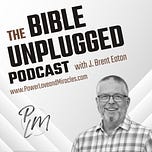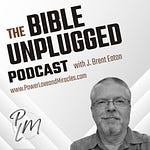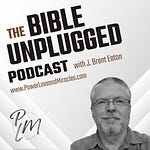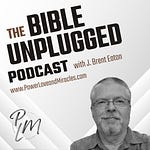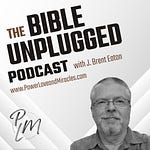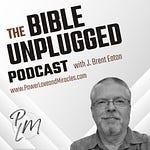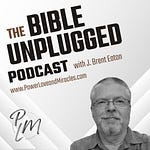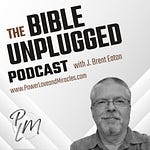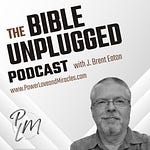Introduction
• While all four gospels have an account of Jesus’ resurrection, the Gospel of John stands out because of the details we find in no other gospel. John is the only writer that tells us about the interaction between Jesus and his disciple Thomas. This event transformed Thomas’ life and is an inspiration for us today.
• I’m Brent and this is episode 35 of The Bible Unplugged. We continue our series, Easter Unplugged, with what Jesus teaches us about grief, doubt, and fear.
• Please take a minute to look at the show notes for this episode at PowerLoveandMiracles.com under the Podcast tab.
Who was Thomas?
• What we know about Thomas comes from the Gospel of John. Thomas is listed as a disciple in Matthew, Mark, Luke, and again in Acts; but those accounts do not give us any details, just his name.
• In the Gospel of John chapter 20, we find that this disciple went by two names: Thomas was his Aramaic name and Didymus was his Greek name. Both words mean “twin.” We assume from that name that Thomas had a twin sibling, but we don’t have any record of that in the New Testament.
• Thomas is mentioned in three chapters in the Gospel of John:
• In the story of Jesus raising Lazarus from the dead, the disciples tried to talk Jesus out of going into Judea because the Jewish leadership wanted to stone Jesus. When Jesus tells of his intent to go to Judea anyway, Thomas tells his fellow disciples, “Let’s also go, that we may die with him.”
• In Jesus’ final sermon in Chapter 14, Jesus tells his disciples that he is going away and that they know where and how to get there. Thomas interrupts Jesus and says, “Lord, we don’t know where you are going. How can we know the way?”
• Thomas is most famous for what happens after Jesus’ resurrection. He has been given the name “Doubting Thomas” because of his disbelief that Jesus came back from the dead.
Jesus and Thomas
• Jesus appeared to his disciples after Mary Magdalene told them Jesus was alive. They were in a locked room, but Jesus appeared in the middle of them and said, “Peace be to you.” This shows that Jesus has an incredible sense of humor. The modern equivalent of what Jesus said is, “Hey. What’s up?” Jesus suddenly appearing to them and being so overly casual about his greeting was absolutely funny.
• Thomas was not with the disciples for that meeting and doubted that Jesus really was alive. Thomas said, “Unless I see in his hands the print of the nails, put my finger into the print of the nails, and put my hand into his side, I will not believe.”
• After eight more days, the disciples, including Thomas, were together again. Jesus suddenly appeared and did the “Peace be to you” thing he did before; but this time, Thomas witnessed it.
• Jesus said to Thomas, “Reach here your finger, and see my hands. Reach here your hand, and put it into my side. Don’t be unbelieving, but believing.” Jesus knew what Thomas needed to accept that He was alive.
• Thomas responded with, “My Lord and my God.”
• Thomas’ doubt suddenly evaporated, but Jesus had more to say, “Because you have seen me, you have believed. Blessed are those who have not seen and have believed.” This statement transcends what television and movie writers call the “fourth wall.” Jesus was not only giving us an example of what happened with his disciples, but it was a direct message to us as well. We are blessed when we believe but haven’t seen.
John’s Literary Style
• The story of Thomas is an example of John’s unique literary style. In several accounts throughout the gospel, we find similar stories that use a physical action as a metaphor for a deeper spiritual truth.
• In this account, Thomas touches the wounds in Jesus’ hands and side which leads to a spiritual awakening when Thomas exclaims, “My Lord and my God.”
• There are several other stories in the Gospel of John that show this structure. I have a list of these in the show notes if you are interested.
What do we learn from this?
• The fact that Jesus rose from the dead and still had the scars from his crucifixion has a lot of meaning.
• When Jesus healed people with disabilities, those physical limitations disappeared. Whatever the disease was that killed Lazarus, for instance, was no longer a problem. So, why did Jesus still have scars?
• Thomas said he would not believe until he placed his finger in the hole in Jesus’ and placed his hand in Jesus’ side. Even before Thomas said this, Jesus had those scars after he came out of the grave. Before the need arose, Jesus had a perfect answer to Thomas’s doubt.
• We may have scars, either physical or spiritual, that God can use to help others who are dealing with similar problems.
• Thomas did not only doubt, he refused to believe Jesus was alive. Jesus did not condemn or scold Thomas for his doubt. Jesus answered Thomas’s doubt with love and compassion.
• I have often heard people say that the presence of doubt is the absence of faith. I disagree. Doubt causes us to examine and investigate what we do not fully understand. When we reach a conclusion, our belief and faith are stronger than before.
• Doubt is a problem when we stop looking for an answer.
• We learn that God meets us where we are and leads us to deeper faith. Thomas was not alone in his doubt. I’m certain he wanted to believe, but something held him back. Jesus came to that room with exactly what Thomas needed to overcome his doubt.
What do we do with this?
• We worship a God who loves us and has compassion for us when we struggle. When you have doubts, continue to seek an answer. God can use your struggle to help you grow stronger. Go to God in prayer this week and present your doubts to Him. Imagine placing those doubts on an altar as a sacrifice. Watch for signs in your life that God is meeting your doubts with an offer of increased faith.
• The pain you have experienced and grown through in your past is a tool God can use to help you minister to others. Ask God to lead you to someone who needs your compassion, and your experience of pain and difficulty to help them grow closer to God.
• We encounter people who beliefs that aren’t quite biblical. Take a close look at some of your strongly held beliefs. Are they really biblical or are they beliefs you have accepted as true without searching for the real answer. Go challenges us to know why we believe, not just what.
The conclusion
• And the music in the background means my time is up for this episode, but I’ll be back with a lot more later.
• I hope this has been helpful. If so, give this podcast a high rating and share it with others.
• In the next episode we will look at Peter’s denial of Jesus and how that led him closer to God.
• My prayer for you is that you will learn and grow through, and beyond, the challenges you faced in the past so you can be an ambassador of God’s grace and love to those who are still struggling.
• Have a blessed week.
The disclaimers
• Just to let you know
• All opinions are my own. If you agree, keep listening. If you don’t… keep listening, I might surprise you with something you didn’t know.
• All Bible quotations come from the World English Bible which is a public domain work.
• Our show theme song is “Awesome Call” by Kevin MacLeod and is available under a Creative Commons license.
• The content of this podcast is copyrighted 2025 by J. Brent Eaton
• This has been a Power Love and Miracles production.
Other Accounts of Doubt in the Gospel of John
1. Nicodemus – Intellectual Doubt
John 3:1–21
Who: Nicodemus, a Pharisee and teacher of Israel.
Doubt Manifested: Literal misunderstanding of being “born again/from above.”
“How can a man be born when he is old?” (John 3:4)
Spiritual Tension: Human reason cannot grasp spiritual rebirth without the Spirit.
Outcome: Nicodemus remains ambiguous, only later reappearing at the burial of Jesus (John 19:39).
2. The Samaritan Woman – Initial Skepticism Turned Faith
John 4:1–42
Who: An unnamed Samaritan woman.
Doubt Manifested: Questions Jesus’s identity and ability:
“Are you greater than our father Jacob…?” (John 4:12)
Spiritual Movement: Doubt leads to dialogue → revelation → testimony → evangelism.
Mystical Parallel: Gradual unveiling of Jesus parallels inner awakening.
3. The Royal Official – Conditional Faith
John 4:46–54
Who: A royal official whose son is ill.
Doubt Manifested: Only believes Jesus after seeing a sign.
“Unless you see signs and wonders, you will not believe.” (John 4:48)
Key Insight: Jesus challenges faith based on signs rather than trust in His word.
Outcome: Believes after his son is healed.
4. The Crowd – Misguided Expectations
John 6:22–71
Who: Crowd fed during the multiplication of loaves.
Doubt Manifested: Demand signs, misunderstand Jesus as merely a provider.
“What sign do you do…?” (John 6:30)
Spiritual Conflict: They can’t accept Jesus as true bread from heaven.
Outcome: Many disciples turn back (John 6:66)—a dramatic moment of mass doubt.
5. Jesus’ Brothers – Superficial Belief
John 7:1–10
Who: Jesus’ own brothers.
Doubt Manifested: Encourage Him to perform miracles publicly.
“For not even his brothers believed in him.” (John 7:5)
Spiritual Irony: Proximity does not guarantee faith; familiarity can breed disbelief.
6. The Jewish Authorities – Hostile Unbelief
Various passages: John 5, 7, 8, 10
Who: Religious leaders and Pharisees.
Doubt Manifested: Repeatedly question Jesus’ authority, accuse Him of blasphemy.
John 8:13: “You are bearing witness about yourself; your testimony is not true.”
Spiritual Pattern: Hardness of heart; inability to hear the Father’s voice or perceive the truth in Jesus.
7. Martha – Limiting Faith
John 11:17–27
Who: Martha, sister of Lazarus.
Doubt Manifested: Believes in future resurrection, but not immediate power.
“Lord, if you had been here, my brother would not have died.” (John 11:21)
Jesus’ Revelation: “I am the resurrection and the life.” (John 11:25)
Outcome: Her partial faith becomes a setting for Jesus’ deeper self-disclosure.
8. Philip – “Show Us the Father”
John 14:8–10
Who: Philip, one of the disciples.
Doubt Manifested: Doesn’t recognize the Father in Jesus.
“Lord, show us the Father, and it is enough for us.”
Jesus' Response: “Have I been with you so long, and you still do not know me?”
Spiritual Theme: The inability to perceive the divine in the human Christ.
9. Thomas – From Skepticism to Confession
John 20:24–29
Who: Thomas the Twin (Didymus).
Doubt Manifested: Refuses to believe without physical proof.
“Unless I see… I will not believe.”
Climax: His encounter leads to the highest Christological confession in John:
“My Lord and my God!” (v. 28)
Spiritual Note: Represents the journey from empirical doubt to mystical vision.
10. Peter – Conflicted Loyalty and Restoration
John 13:36–38; John 21
Who: Simon Peter.
Doubt Manifested: Denies Jesus three times despite initial boldness.
“I will lay down my life for you.” → “I am not [his disciple].”
Restoration: Jesus’ threefold “Do you love me?” in John 21 heals the earlier doubt.


